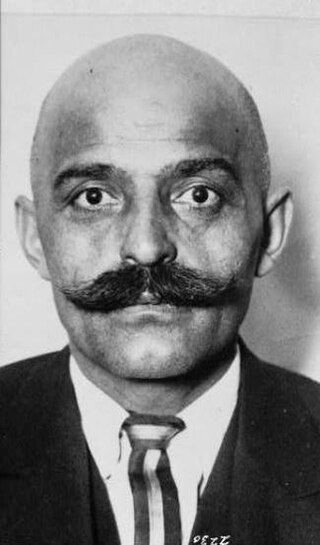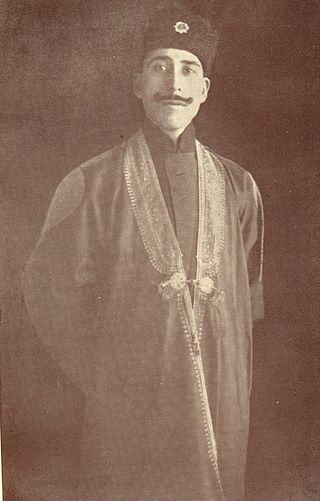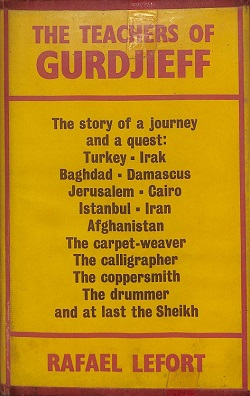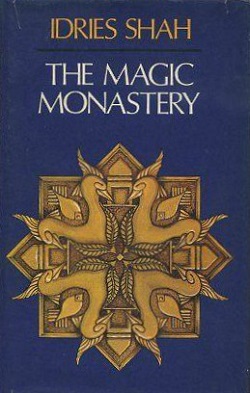Related Research Articles

Zarathushtra Spitama, more commonly known as Zoroaster or Zarathustra, was an Iranian religious reformer who challenged the tenets of the contemporary Ancient Iranian religion, becoming the spiritual founder of Zoroastrianism. Variously described as a sage or a wonderworker; in the oldest Zoroastrian scriptures, the Gathas, which he is believed to have authored, he is described as a preacher and a poet-prophet. He also had an impact on Heraclitus, Plato, Pythagoras, and the Abrahamic religions, including Judaism, Christianity, and Islam.

George Ivanovich Gurdjieff was a philosopher, mystic, spiritual teacher, composer, and dance teacher. Gurdjieff taught that people are not conscious of themselves and thus live their lives in a state of hypnotic "waking sleep", but that it is possible to awaken to a higher state of consciousness and serve our purpose as human beings. The practice of his teaching has become known as "The Work" and is additional to the ways of the Fakirs (Sufis), Monks and Yogis, so that his student P. D. Ouspensky referred to it as the "Fourth Way".

Idries Shah, also known as Idris Shah, Indries Shah, né Sayed Idries el-Hashimi and by the pen name Arkon Daraul, was an Afghan author, thinker and teacher in the Sufi tradition. Shah wrote over three dozen books on topics ranging from psychology and spirituality to travelogues and culture studies.
The Gurdjieff movements are a series of sacred dances that were collected or authored by G. I. Gurdjieff. He taught his students as part of the work of self observation and self study.
John Godolphin Bennett was a British academic and author. He is best known for his books on psychology and spirituality, particularly on the teachings of G. I. Gurdjieff. Bennett met Gurdjieff in Istanbul in October 1920 and later helped to co-ordinate the work of Gurdjieff in England after the guru had moved to Paris. He also was active in starting the British section of the Subud movement, and co-founded its British headquarters.

Balkh is a town in the Balkh Province of Afghanistan. It is located approximately 20 kilometres (12 mi) to the northwest of the provincial capital city Mazar-i-Sharif and approximately 74 kilometres (46 mi) to the south of the Amu Darya and the Afghanistan–Uzbekistan border. In 2021–2022, the National Statistics and Information Authority reported that the town had 138,594 residents. Listed as the eighth largest settlement in the country, unofficial 2024 estimates set its population at around 114,883 people.
A teaching story is a narrative that has been deliberately created as a vehicle for the transmission of wisdom. The practice has been used in a number of religious and other traditions, though writer Idries Shah's use of it was in the context of Sufi teaching and learning, within which this body of material has been described as the "most valuable of the treasures in the human heritage". The range of teaching stories is enormous, including anecdotes, accounts of meetings between teachers and pupils, biographies, myths, fairy tales, fables and jokes. Such stories frequently have a long life beyond the initial teaching situation and have contributed vastly to the world's store of folklore and literature.
In Tibetan Buddhist tradition, Shambhala, also spelled Shambala or Shamballa, is a spiritual kingdom. Shambhala is mentioned in the Kalachakra Tantra. The Bon scriptures speak of a closely related land called Tagzig Olmo Lung Ring.
Surmang refers to a vast alpine nomadic and farming region, historically a duchy under the King of Nangchen, with vast land holdings spreading over what is today the Tibet Autonomous Region and Qinghai Province. In Tibetan the King of Nangchen's realm was called the "nyishu dza nga" or the 21 (provinces). Since 1959 it is mainly within the Yushu Tibetan Autonomous Prefecture of Qinghai province in China. Yushu Prefecture is 97% ethnic Tibetan. The Surmang region is one of the poorest regions in China ranking it among the world's highest infant and maternal mortality, almost 100% illiteracy, and personal income of less than US 14¢/day. It is part of the catchment in China of the 30 million ultra-poor.

Sirdar Ikbal Ali Shah was an Indian-Afghan author and diplomat descended from the Sadaat of Paghman. Born and educated in India, he came to Britain as a young man to continue his education in Edinburgh, where he married a young Scotswoman.

The Teachers of Gurdjieff is a book by Rafael Lefort that describes a journey to the Middle East and central Asia in search of the sources of G. I. Gurdjieff's teaching, and culminates in the author's own spiritual awakening, by meeting and "opening" to the teachings of the Naqshbandi Sufis. The author's search finally leads him to the Sarmoun monastery in Northern Afghanistan where Gurdjieff had been previously taught.
Karma Lingpa (1326–1386) was the tertön (revealer) of the Bardo Thodol, the so-called Tibetan Book of the Dead. Tradition holds that he was a reincarnation of Chokro Lü Gyeltsen, a disciple of Padmasambhava.

Khwājagān is a Persian title for "the Masters". Khwajagan, as the plural for "Khwāja", is often used to refer to a network of Sufis in Central Asia from the 10th to the 16th century who are often incorporated into later Naqshbandi hierarchies, as well as other Sufi groups, such as the Yasaviyya. In Firdowsi's Shahnama the word is used many times for some rulers and heroes of ancient Iran as well. The special zikr of the Khwajagan is called 'Khatm Khajagan'.

Tales of the Dervishes by Idries Shah was first published in 1967, and re-published and made available online for free by The Idries Shah Foundation in October 2016.
Octagon Press was a cross-cultural publishing house based in London, UK. It was founded in 1960 by Sufi teacher, Idries Shah to establish the historical and cultural context for his ideas. The company ceased trading in 2014.

The Eleven Naqshbandi principles or the "rules or secrets of the Naqshbandi", known in Persian as the kalimat-i qudsiya, are a system of principles and guidelines used as spiritual exercises, or to encourage certain preferred states of being, in the Naqshbandi Sufi order of Islamic mysticism.

The Boy and the Filberts is a fable related to greed and appears as Aarne-Thompson type 68A. The story is credited to Aesop but there is no evidence to support this. It is not included in either the Perry Index or in Laura Gibbs' inclusive collection (2002).

Lataif-e-sitta are special organs of perception in Sufi spiritual psychology, subtle human capacities for experience or action. Depending on context, the lataif are also understood to be the qualities of consciousness corresponding to those experiences or actions.

The Magic Monastery is a collection of teaching stories from the Sufi mystical tradition, by the writer Idries Shah, together with some stories by the author himself.
References
- 1 2 Sedgwick, Mark. "European Neo-Sufi Movements in the Inter-war Period" appearing in Islam in Inter-War Europe , edited by Natalie Clayer and Eric Germain. Hurst, London.
- 1 2 3 4 Bennett, John G., Gurdjieff: Making of A New World, pp 56-57, Bennett Pub. Co., 1992. ISBN 0-9621901-6-0.
- ↑ Moore, James, Gurdjieff: The Anatomy of a Myth: A Biography, Element Books, 1993. ISBN 1-85230-450-2.
- 1 2 Gurdjieff, G. I., Meetings with Remarkable Men, Penguin (Non-Classics), 1991. ISBN 0-14-019037-6.
- ↑ Gilbert, Adrian G., Magi: The Quest for a Secret Tradition, Bloomsbury Publishing, 1996. ISBN 0-7475-3100-5.
- 1 2 3 Martin, Major Desmond R., "Account of the Sarmoun Brotherhood", Documents on Contemporary Dervish Communities, a symposium collected, edited and arranged by Roy Weaver Davidson, Octagon Press 1966, 1982. ISBN 0863040152. First publication: Major Desmond R. Martin, The Editor of The Lady, "Below the Hindu Kush", The Lady, vol. CLX11, No. 4210, December 9, 1965, p. 870.
- 1 2 Scott, Ernest, The People of the Secret, p74, Octagon Press, London, 1985. ISBN 0-86304-038-1.
- ↑ Elusive Guardians of the Ancient Secrets
- ↑ Moore, James (1986). "Neo-Sufism: The Case of Idries Shah". Religion Today 3
- ↑ Studies in Comparative Religion, pp 25, 214, Tomorrow Publications, Winter 1974.
- ↑ Ouspensky Foundation: History of the Work of Gurdjieff. Retrieved on 2008-11-14.
- ↑ Bennett, John G., The Masters of Wisdom, pp 57, 64, Bennett Books, 1995, ISBN 1-881408-01-9.
- ↑ Perry, Whitall N., Gurdjieff in the Light of Tradition , p7, Sophia Perennis, 2002. ISBN 0-900588-75-6.
- ↑ Fordham, Walter (October 2003). "Interview with James George: June 27th, 2003". Chronicles of Chögyam Trungpa Rinpoche. Retrieved 1 April 2015.
Gurdjieff spent three and a half years in Tibet. He wrote ... that he was taken to a central Asian monastery in Kashmir or Tibet called a monastery of the Sarmoung brotherhood. Now, Surmang, the seat of Trungpa's lineage, is just a transposition of vowels, which I think, may conceal where Gurdjieff received much of his teaching.
- ↑ "Beelzebub'S Buddhas". www.endlesssearch.co.uk.
- ↑ Nathalie Clayer-Eric Germain Islam In Inter-War Europe , p. 208, Columbia University Press, 2008 ISBN 978-0-231-70100-6
- ↑ Moore, J. Gurdjieff, The Anatomy of a Myth. Element books, 1991, p31